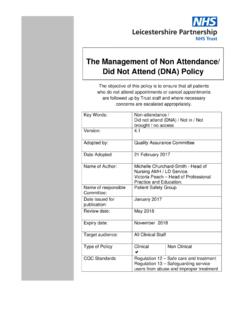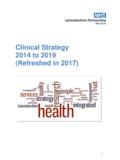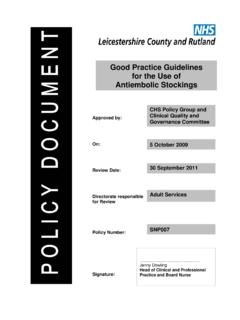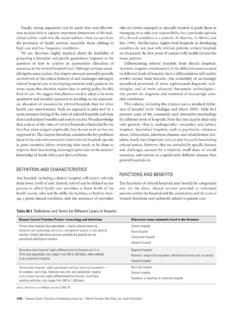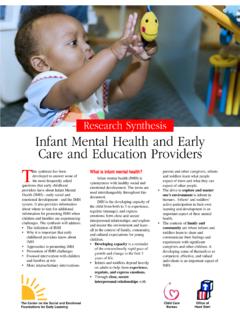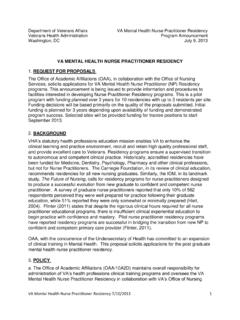Transcription of Medical Education Strategy 2014-2019
1 Leicestershire Partnership NHS Trust Medical Education Strategy (FINAL) Author: Dr J West 1 | P a g e September 2014 Medical Education Strategy 2014 - 2019 Leicestershire Partnership NHS Trust Medical Education Strategy (FINAL) Author: Dr J West 2 | P a g e September 2014 Summary The Medical Education Strategy , which sets the vision for the next five years ( 2014 to 2019 ), has been developed following a review of the evidence and research concerning the changes in structure, delivery and funding of Medical Education in a changing environment in which the Medical workforce will need to be flexible and responsive to population health needs and workforce demand. There is an explicit understanding that structured, protected training of consistently high quality, properly supervised, and is essential to enable doctors to become knowledgeable clinical leaders who contribute to excellent patient care throughout their Medical careers.
2 The Strategy provides a comprehensive review of Medical Education , highlights key challenges and risks, and identifies key requirements for the delivery of a new vision for Medical Education in the Trust. Vision for Medical Education : Leicestershire Partnership NHS Trust will develop outstanding Medical practitioners through its commitment to achieving excellence in Education for all trainees and doctors throughout their Medical careers. In developing and identifying the strategic aims of the Strategy , a number of assumptions have been made: We will support the delivery of Medical Education through the continuum of undergraduate Medical Education , post graduate and continuing professional Education for all doctors We will develop caring, safe and effective doctors who are supportive of Trust values We will actively facilitate and promote learning between staff We will develop and quality assure a skilled educator workforce We will maximise the use of technology enhanced learning We will work with the specialty schools to develop a quality dashboard of Medical training posts We will strive to meet the quality control requirements of Health Education East Midlands, Leicester Medical School and the General Medical Council Four overarching strategic aims have been identified and discussed in various Trust forums.
3 These aims are: Overarching Objectives: 1. Provide an Education & learning environment that supports safe patient care 2. Establish a reputation for excellent teaching and training in order to attract and retain high quality Medical workforce 3. Create an educational environment where innovation and research can flourish 4. Ensure that systems are in place to demonstrate quality assurance of undergraduate and postgraduate Medical Education Leicestershire Partnership NHS Trust Medical Education Strategy (FINAL) Author: Dr J West 3 | P a g e September 2014 Introduction The purpose of this document is to describe the Medical Education strategic approach 2014 -19, which has been developed to align with Leicestershire Partnership Trust s strategic objectives. This approach is guided by the Human Resources & Organisational Development Strategy 2013/14 2015/16, and should be read in conjunction with the following documents.
4 Leicestershire Partnership NHS Trust Clinical Strategy 2014 -19 Leicestershire Partnership NHS Trust Approach to Learning & Development 2013-16 Scoping Review of Multi-Professional Education within Leicester Partnership Trust - December 2013 Improving the Student and Teacher Experience of Clinical Teaching - report following Education Event - December 2013 This approach responds to recent changes in the structure, delivery and governance of Medical Education , outlines the new working relationships which will be required with East Midlands Local Education and Training Board, who commission, lead and manage Medical Education and training at Health Education East Midlands and identifies key challenges for the Trust. Organisational Context Leicestershire Partnership NHS Trust (LPT) provides high quality integrated mental health, learning disability and community health services.
5 The Trust works with primary care, local hospitals, social services and other Local Authority departments such as housing and Education . The Trust also works with voluntary organisations and local community groups. Services in LPT are organised into three operational divisions: Adult Mental Health and Adult Learning Disability Services; Families, Young People and Children's Services (FYPC); and Community Health Services (CHS). The Trust was created in 2002 to provide mental health, learning disability and substance misuse services. In April 2011 the Trust merged with Leicester City and Leicestershire County and Rutland Community Health Services, as a result of the national Transforming Community Services agenda, which increased the annual turnover of the organisation from 138m in 2010/11 to approximately 282m in 2011/12 with a corresponding increase in staff from approximately 2,700 to 5,700 into a single organisation.
6 This provided the opportunity for the trust to deliver a fully integrated health and wellbeing service. In doing so, the range of services that are provided has significantly increased. The vision is to create a truly integrated trust where services are joined up to deliver new care pathways, which aim to meet both the physical and mental health needs of the population. Leicestershire Partnership NHS Trust Medical Education Strategy (FINAL) Author: Dr J West 4 | P a g e September 2014 Leicestershire Partnership Trust Vision & Strategic Objectives In 2014 the Trust Board adopted a new vision for the Trust; this followed engagement with senior leaders, shadow governors and divisional management teams. To improve the health and wellbeing of the people of Leicester, Leicestershire and Rutland by providing high quality, integrated physical and mental health care pathways Leicestershire Partnership NHS Trust Medical Education Strategy (FINAL) Author: Dr J West 5 | P a g e September 2014 Key Challenges for Medical Education in the Trust Medical Education and training are being delivered in a changing environment.
7 There are challenges in providing high quality Medical Education which ensure competency, maintain confidence and promote excellence in a system having to manage increases in clinical demand, different and rising expectations from staff and patients, while harnessing opportunities created by technological innovation. Doctors will more than ever be expected to exercise leadership, understand how the systems in which they work operate, contribute to, and where appropriate lead, multi-professional teams (GMC 2011). To do this, doctors need structured, protected training of consistently high quality to enable them to become knowledgeable clinical leaders who contribute to excellent patient care throughout their Medical career. Leicestershire Partnership NHS Trust provides Education to the Medical workforce through the continuum of undergraduate Medical Education , post graduate and continuing professional Education for all doctors throughout their career.
8 The Trust provides a large proportion of the School of Psychiatry postgraduate training programme in psychiatry for trainees in the South of the region for 68 trainees at CT1-ST6, 1 Based trainee, 16 Foundation trainees and 14 in GP training posts. In addition, Level 2 Paediatric, 1 level 3 Community Paediatric trainees and 1 GP trainee undertake Community Paediatric rotational posts within the Trust. Teaching and training is a key component of the Trust s business with the aims of attracting and retaining the best staff and partnering with leading educational providers to deliver a well-trained and educated workforce. Although General Psychiatry currently ranks as one of the specialties with the largest number of registered specialists and number of trainees, there is evidence that there are not enough psychiatrists to meet service needs. The Royal College of Psychiatry s 2011 workforce census estimated that 151 Consultant psychiatry posts were unfilled across England, Wales and Northern Ireland.
9 The Centre for Workforce Intelligence, which is responsible for NHS workforce planning and development in England, has modelled the number of 2011 trainees required in general psychiatry and noted that psychiatry continues to be seen as a relatively unattractive specialty choice for trainees. It concluded that, although there is clear need in psychiatry, historical trends indicates that any new posts would be likely to remain unfilled, and that more work is needed to improve the attractiveness of the specialty to potential applicants. This under-supply is problematic given that the ageing population for whom comorbidities and dementia are common is likely to place further demands on psychiatric services, Nationally, of UK Medical graduates intend to apply for UK specialty training programme in psychiatry at start of F1 (2013), and on average only entering a career in the specialty.
10 Locally, of Leicester Medical School graduates enter core psychiatric training. The national F2 Career Destination Survey (2013) showed a fill rate of 89% at CT1 for psychiatry, although encouragingly, local data from recruitment rounds at CT1 and ST4 demonstrate 100% fill rates for posts in the East Midlands (National Psychiatry Recruitment Service: 26 October 2013). The Trust needs to consider how to continue to recruit and to retain the highest calibre of trainees from the relatively small number who opt for a career in the specialty in order to support safe clinical care, and to maximise the Trust s reputation as an excellent place to train in psychiatry. In order to do this the Trust will need to work with the specialty school to develop a quality dashboard of Medical training posts. If the Trust can demonstrate that it provides high quality posts and contributes to the development of future attachments the trust will attract training funding because training posts can be designed from the information that the dashboard would provide.


